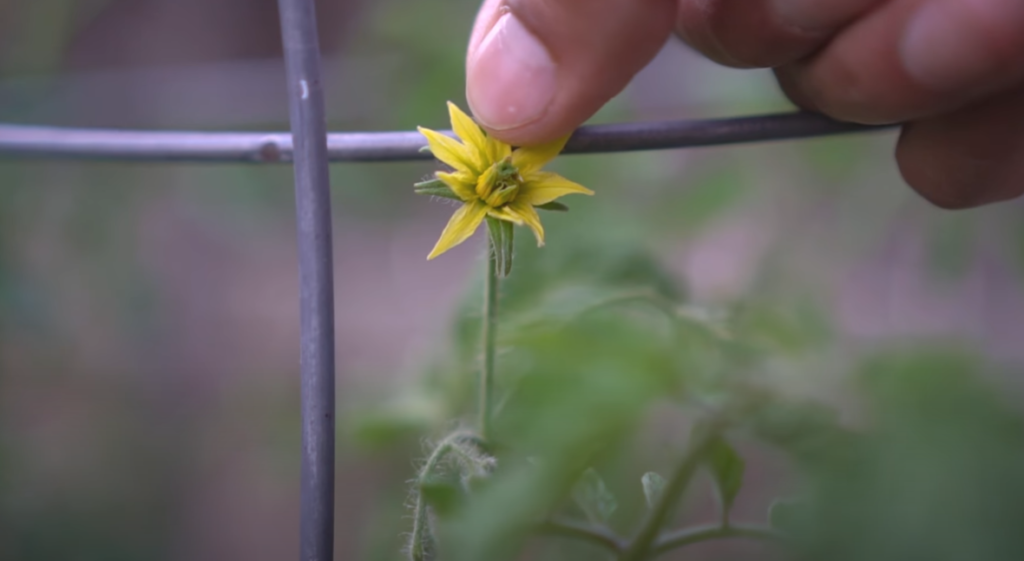
How to Get Your Tomato Plant to Flower?
Cultivating a thriving tomato plant that yields a rich bounty of fruit begins with fostering an environment conducive to flower production. This requires comprehensive understanding of the plant’s botanical needs, including optimal nutritional balance, precise lighting and temperature conditions, and effective pruning techniques.
Additionally, identifying and resolving common flowering issues can significantly improve your plant’s productivity. This guide provides a meticulous approach to mastering the art of inducing your tomato plant to flower, serving as a valuable resource for both novice and seasoned gardeners seeking to optimise their tomato harvest.
- Proper tomato variety selection is important for a plant’s potential to thrive and bear fruit.
- Adequate nutrition, including nitrogen, phosphorus, and potassium, is crucial for tomato plants to flower and bear fruit.
- Optimal light intensity and temperature are essential for robust flowering.
- Regular pruning promotes flower production by directing the plant’s energy and improving air circulation.
Understanding Tomato Plant Basics
The fundamental understanding of tomato plant biology is crucial for successful cultivation and flowering. Mastery of this knowledge begins with the proper tomato varieties selection, an aspect that largely influences the plant’s potential to thrive and bear fruit. Different varieties have varying characteristics, including adaptability to environmental conditions, resistance to diseases, and yield potential. Therefore, choosing the appropriate variety is the initial step in ensuring successful cultivation.
Equally vital are soil preparation techniques. The soil is the primary source of nutrients and water for the plant. Preparing it involves enhancing its structure, fertility, and pH balance to create the optimal conditions for growth. These techniques include tilling, composting, and lime application.
Thus, understanding tomato plant biology and implementing correct practices guarantees fruitful cultivation.
Importance of Proper Plant Nutrition
Ensuring adequate nutrition for your tomato plants plays a pivotal role in their ability to flower and bear fruit. Nutrient deficiency effects may include poor growth, reduced flowering, and underdeveloped fruits.
For a balanced diet, focus on these three elements:
- Nitrogen: Essential for leaf growth.
- Phosphorus: Promotes root development and flowering.
- Potassium: Enhances fruit quality and disease resistance.
Organic fertilisers usage is an excellent approach to provide these nutrients. They release nutrients slowly, improving soil structure and promoting healthier root systems. Organic fertilisers also contain micronutrients often missing in synthetic versions.
The Role of Light and Temperature
Optimal light and temperature conditions significantly influence the flowering of tomato plants. The light intensity effects play a crucial role in photosynthesis, a process essential for plant growth and flower development. An exposure of 14-16 hours of bright, indirect sunlight daily is recommended for robust flowering. However, this intensity should be regulated to avoid leaf burn.
The optimal temperature range for tomato plants lies between 55°F and 85°F. This range stimulates the production of growth hormones, resulting in abundant flowering. Temperatures below or above this range can hinder the plant’s ability to produce flowers. It’s vital to modulate these factors, allowing the plant to thrive and yield a plentiful harvest. Want to know more? Check out our helpful resources: Tomato Mentor
Following these guidelines will foster optimal tomato plant flowering.
Pruning Practices for Flowering
Regularly pruning your tomato plants is another crucial strategy to stimulate flowering, following the control of light and temperature conditions. This practice involves removing unnecessary growth to direct the plant’s energy towards flower production.
- Pruning for disease prevention: Pruning reduces plant density, improving air circulation, thereby decreasing the risk of fungal diseases.
- Pruning promotes better light exposure: By eliminating excess foliage, light reaches all parts of the plant, essential for photosynthesis and the subsequent flowering process.
- Pruning and mulching benefits: Pruned material can be used as mulch, maintaining soil moisture and temperature, while suppressing weeds.
Mastering these pruning practices will certainly enhance your plant’s flowering potential, contributing to a healthier and more productive tomato plant.
Troubleshooting Common Flowering Issues
Although tomato plants typically flourish under proper care and conditions, they may experience common flowering issues that require effective troubleshooting strategies. Among these are pest interference and disease prevention, which are integral to maintaining a healthy, flowering tomato plant.
| Issue | Solution |
| Blossom end rot | Apply calcium to the soil |
| Pest interference | Use organic pesticides |
| Overwatering | Water only when soil is dry |
| Disease prevention | Use disease-resistant varieties |
Blossom end rot is caused by calcium deficiency, which can be solved by applying calcium to the soil. Pests can interfere with flowering, and organic pesticides are recommended to mitigate this issue. Overwatering is a common problem and it’s advisable to water only when the soil is dry. Lastly, planting disease-resistant varieties is a proactive approach to disease prevention.
Frequently Asked Questions
What Are Some Organic Methods to Encourage Tomato Plants to Flower?
Implementing composting techniques and using organic fertilisers rich in phosphorus can enhance blossoming. Regular watering and proper sunlight exposure are also crucial to encourage the flowering process in tomato plants organically.
How Can I Attract Pollinators to My Tomato Plants for Increased Flowering?
To attract pollinators to your tomato plants, enhance pollinator diversity by planting native flowers nearby. This creates an inviting habitat for native pollinators, encouraging frequent visits and subsequently increasing tomato plant flowering.
What Other Plants Can I Grow Alongside My Tomato Plants to Support Their Flowering?
Companion planting benefits tomato plants. Ideal plant partners include basil, marigold, and mint, enhancing growth and flowering potential by attracting beneficial insects and deterring pests. This symbiotic relationship fosters a robust, productive garden environment.
How Can I Protect My Flowering Tomato Plants From Pests Without Using Harsh Chemicals?
Utilising natural predators and companion planting can effectively safeguard your flowering tomato plants. Predators control pests naturally, while certain companion plants deter pests with their scent or by attracting beneficial insects.
Can I Force a Tomato Plant to Flower Indoors and How Would I Do This?
Forcing a tomato plant to flower indoors? Interestingly, it’s possible! Choose indoor tomato varieties, meet their light requirements, and provide optimal care. The plant will reward you with blooms, followed by delicious fruit.
Conclusion
In conclusion, successful tomato plant flowering is a result of understanding plant basics, ensuring optimal nutrition, balancing light and temperature, and proficient pruning practices.
Troubleshooting common issues is vital in maintaining plant health.
By integrating these strategies, one can cultivate a flourishing tomato plant, thus demonstrating the symbiotic relationship between humanity and nature.
It is a testament to the profound power of knowledge and careful cultivation in achieving agricultural success.







